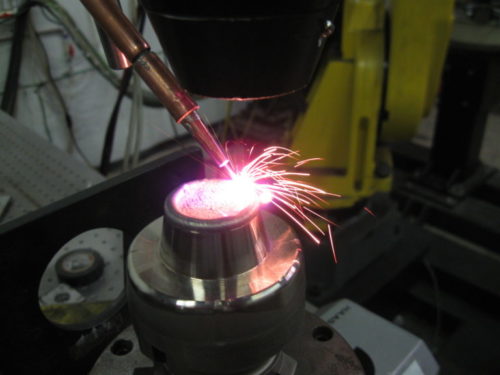What Metals Can You Braze?
Comments Off on What Metals Can You Braze?
Brazing is used to join metal parts and can be applied to a wide array of materials, like brass, copper, stainless steel, aluminum, zinc-coated steel, and ceramics. Laser brazing offers some distinct advantages in applications that require the joining of non-similar metals.
What Is Brazing?
Brazing is a process by which non-ferrous filler metals or braze alloys are melted between two or more close-fitting base metal parts to form a joint. The technique involves heating components above the braze alloy melt temperatures and below the melting temperature of the base metal, allowing capillary action to distribute the molten filler throughout the joint between the two pieces to be brazed. As the braze alloy cools, a strong joint or seal forms.
Laser brazing replaces the use of an oxy-acetylene flame, the most common heat source in other brazing techniques, with a laser to allow for more localized heat application.
What Metals Can Be Brazed?

- Brass
- Copper
- Stainless steel
- Aluminum
- Zinc-coated steels
It is also effective in joining mixed materials like tungsten carbide or silicon nitride—a highly durable ceramic—to itself or metal parts.
Many HVAC and A/C units are made of aluminum components because of the metal’s high strength, light weight, and resistance to rust. Brazing is commonly used in these applications to provide reliable, leak-proof connections. However, aluminum is notoriously challenging to work with as a result of its low melting temperature and its reliance on selecting the appropriate alloy and flux for the specific application. In these instances, laser brazing offers an advantage over traditional brazing because in some cases, it can be used without flux, and its more precise approach to the heating process allows for filler material to be targeted while maintaining the integrity of the aluminum base.
Filler materials in laser brazing are often made of aluminum bronzes, a corrosion-resistant, copper-based alloy noted for its strength.
<Find out how laser hardening is used for industrial components.>
Advantages of Laser Brazing for Mixed Metals
Brazing is regularly used in place of welding in applications that require the joining of non-similar metals when differences like melting temperature or appreciable solubility make them incompatible without the use of an interface layer.
Two key advantages of using laser brazing for mixed metal applications include:
Lower Temperatures
Laser brazing works to localize heat dispersion by using independent beams to heat both the filler material and base metals more precisely, helping to reduce part distortion as compared to the traditional torch, furnace, and arc brazing techniques. This targeted heating allows for greater energy efficiency and improves processing times.
Reduced Costs
Laser brazing does not require unique coils or parts for different applications, omits the need for flux, improves energy efficiency, and increases the processing rate due to reduced cool-down times after brazing. Additionally, the process can be automated to improve part quality. These reductions in manufacturing materials help lower total production costs.
Brazing is an invaluable alternative to welding when it comes to joining metals whose metallurgy does not align. More specifically, laser brazing provides a host of benefits that lead to greater efficiency and lower production costs in mixed metal applications.
For more information on the benefits of laser brazing or to learn about our other laser processing services, contact the team at Titanova today.
